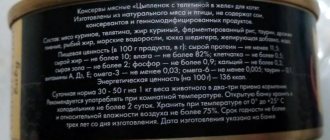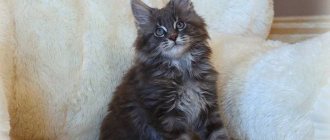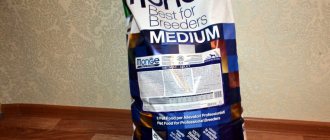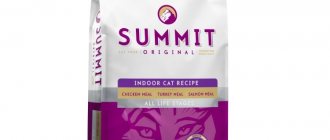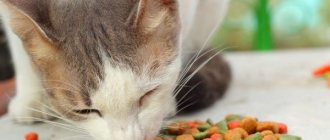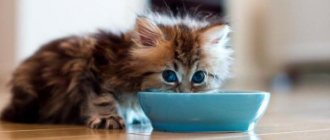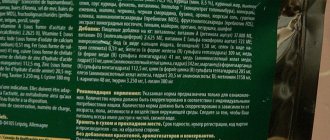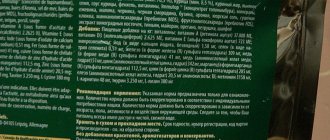What to feed your cat? This question worries all owners of mustachioed pets in one way or another. For a number of reasons, natural food at home cannot be considered healthy and balanced for cats, and, fortunately, many understand this and therefore switch to ready-made professional food.
Read more: Natural food for cats: benefit or harm?
Fortunately, the range of these foods today is simply huge; there is always the opportunity to choose the appropriate food based on price, pet preferences, according to the veterinarian’s recommendations, etc. But are all professional foods equally useful, and can they all be recommended? How do they differ from each other, besides the cost? The specialists of the Murkosha shelter will help you figure it out!
1) What does food class mean? 2) How to distinguish good food from bad food? 3) Economy class food - what is it? 4) Meat in the food, or rather, its absence 5) The presence of grains 6) Synthetic additives, vitamins and minerals 7) Conclusions
What does feed class mean?
There is a concept of “class” of food - this indicates how healthy the composition of a particular food is, natural, enriched with vitamins and minerals, in other words, how much it corresponds to the ideal diet for a cat (as an example, you can take the diet of the wild ancestors of domestic cats in natural conditions). Usually there are 4 classes:
— economy — premium — superpremium — holistic
Sometimes another class is distinguished - medium, which occupies an intermediate place between economy and premium. It must be said that the classes themselves and their boundaries are quite arbitrary (this is partly why there are different numbers of classes). Manufacturers themselves do not always position their products as belonging to a specific class (although such cases also occur, especially when it comes to the super-premium class and holistic products); more often, the division into classes reflects the opinion of veterinarians, felinologists, and various experts. Often, different experts classify the same food into different “neighboring” classes (for example, some consider it premium, while others consider it superpremium). It also happens that a particular brand has many different lines, not always of equal quality, which is also reflected in the division into classes. Finally, even within the same class you can find food of higher and lower quality (according to the opinion of most experts). However, while such boundaries are arbitrary, the class of food can give potential buyers a general idea of the quality of the product.
Dog diet
Every dog owner, especially if this is their first pet, faces a very important question: how to choose the right diet for your pet or what food is best to choose?
The following options are possible:
- dry food only;
- only natural food;
- mixed diet (one food is dry food, the second is natural food).
Strong arguments in favor of dry food are:
- balanced diet;
- saving time on cooking;
- no problems with food storage and freshness.
Even a child can pour the required amount of “crackers” for a pet without any problems, while natural food must be prepared, stored in the refrigerator and heated before serving.
Indeed, all ingredients in specialized feeds are selected in certain proportions and quantities in order to fully satisfy the needs of the animal. They also contain vitamins and minerals in the right ratios to keep your dog healthy and energetic. It is unlikely that homemade porridge with meat will be able to compete with food that is developed by professionals in this field and undergoes various tests in laboratories. After all, no matter how hard the owner tries, he still will not be able to make a diet with a balance of vitamins, minerals, nutrients, and proteins identical to dry food.
Meat in the feed, or rather, the lack thereof
The main complaint about economy-class cat food is the quantity and quality of meat in it (and this is quality criterion No. 1). Very often, manufacturers of these products do not indicate the percentage of meat in the composition at all. However, there is a rule: in the first positions are those ingredients that are the most in the composition. So, in economy-class food, meat, as a rule, is far from being in first place.
It’s even worse that in the composition you can see some not entirely clear wording, for example, “meat and its processed products,” while the manufacturer is silent about what percentage of meat and what percentage of “processed products” it is. And what exactly is hidden behind the words “meat processing products”?
Practice shows that to produce economy-class food for cats, waste from the meat industry is used, something that is unsuitable for human nutrition: skin, ears, tails, sinews, as well as bone meal in large quantities. Of course, your pet will not receive any beneficial substances from such a set of ingredients.
Pros and cons of natural food
Natural foods are considered more common, but this does not mean that your pet should only eat raw meat. His diet should also include vegetables, grains, fish, dairy products, and eggs.
You need to prepare food daily. Natural food that is healthy for humans is not always suitable for a pet, so before switching to such food, you should familiarize yourself with its pros and cons.
The main advantages of “natural”:
- only fresh natural ingredients are used;
- the high moisture content of food prevents thirst;
- it is as close as possible to the pet’s natural food.
This type of nutrition also has disadvantages:
- the complexity of the preparation process;
- you should create a menu, calculating the amount of healthy ingredients;
- irregular bowel movements in cats;
- a properly balanced natural mixture costs much more than an industrial one;
- the need for daily preparation;
- You need to additionally introduce a vitamin-mineral complex, depending on the time of year.
Availability of cereals
You may ask: what about the balance of proteins, fats and carbohydrates? Manufacturers are required to indicate their ratio on the packaging. Moreover, there are certain standards for animal feed, and if, for example, there is not enough protein in the feed, then such products may not be allowed to be sold.
The minimum acceptable percentage of protein in cat food per 100 g of product is 26%. However, volunteers and specialists of the Murkosha shelter, based on numerous studies and the opinions of veterinarians, draw your attention to the fact that this is the lower limit, the limit of the norm. It barely meets the cat's protein needs. The optimal ratio of proteins in food is about 40% (a higher percentage is also not very healthy). The minimum for fat is 9%, the maximum limit is 20%. In this case, the percentage of carbohydrates and fiber should ideally be in the range of 10-20%.
Read more about the composition: Composition of dry cat food: let’s look at the nuances
Economy-class food for cats and kittens contains the required amount of proteins (otherwise they simply will not meet the standards), although, as a rule, their value is close to the minimum acceptable limit. How so? After all, it is obvious that there cannot be such a quantity of proteins in waste and bone meal.
The thing is that manufacturers of economy-class feed replace animal proteins with plant proteins. The source of the latter is wheat or corn flour - these are the ingredients that usually come first in the composition (and this is our criterion No. 2). Why is this bad, since in both cases we are talking about proteins? But animal and plant proteins have different compositions of amino acids (basic nutrients used by the body). For example, plant foods contain too little of one of the essential amino acids – lysine. As a result, the value of plant proteins is only 60-80% compared to animal proteins.
There is also an amino acid called arginine. The daily recommended intake of this substance for cats is quite high: a cat weighing 4.5 kilograms needs approximately 855 mg of arginine per day. And arginine is most abundant in animal proteins, while in plant proteins it is significantly less. Therefore, if the diet is based on plant proteins, the mustachioed pet will not receive the required daily requirement of arginine. This can have serious consequences for cats. Arginine helps your cat's liver remove digestive byproducts (such as ammonia), so a deficiency will be similar to poisoning. The easiest signs of arginine deficiency are depression, drowsiness, decreased immunity and poor coat. The most severe include kidney and heart diseases, hormonal disorders, vomiting, convulsions and even lethargic sleep.
And this is not the only problem with feeds high in wheat or corn. These cereals are very high in carbohydrates (up to 70%). And carbohydrates sharply increase blood sugar levels. The cat's body is not adapted to such sudden jumps in glucose levels, so foods high in carbohydrates can lead to the development of diabetes mellitus and even kidney and liver failure in the pet. There is a third problem - cats often have an allergic reaction to corn or wheat gluten.
Read about food allergies: Food allergies in cats
Thus, plant proteins can in no way be considered a replacement for animal proteins, as a result of which economy-class food for cats and kittens is more harmful than beneficial.
Characteristics of economy class feed
Economy class feed, as is easy to understand from their name, allows the buyer to save money. This attracts primarily low-income segments of the population. And some cat owners simply believe that it is not worth spending a lot of money on animals, and limit themselves to the most inexpensive food option possible.
Economy class food is sold not only in pet stores, but also in supermarkets, as well as in regular grocery stores.
Why are economy feeds so cheap? This suggests a conclusion about their low quality. And that's true. Such feeds are characterized by a poor composition, in which plant components predominate, as well as by-products of dubious quality and unknown origin. It can be:
- cereals;
- corn gluten;
- wheat and soy flour;
- meat flour;
- offal;
- animal fats.
Most often these are residues from food production or waste from slaughterhouses. The not very attractive composition is supplemented with unhealthy dyes, flavors, preservatives and antioxidants, and, on the contrary, there are very few beneficial additives such as vitamins, minerals or prebiotics. Artificial flavorings make food more attractive to pets and lead to addiction, which may cause your cat to refuse better quality food.
Preservatives, dyes and antioxidants in economy class food are always of artificial origin, but the composition of Friskies food at least reflects their presence, whereas they are simply not indicated in products of other brands
The composition of economy feed would be quite suitable for people, because we are omnivores. However, cats are carnivores, eating meat and poultry in nature. Even fish and dairy products are not suitable food for them. Therefore, only food in which meat predominates will be a complete and nutritious food for cats. From plant components, cats experience digestive disorders and allergic reactions, they gain excess weight and develop chronic diseases. Veterinarians strongly advise against feeding on economy-class food. Moreover, owners turn to them at a stage when the cat’s health has already been seriously undermined by an incorrect diet. And the reason is not at all because of feeding dry food, but because it was dry or wet food of low quality.
Synthetic Supplements, Vitamins and Minerals
So, it contains wheat (and/or corn) flour, bone meal, waste from the meat industry... What cat in its right mind would eat this?! But cats often gobble up economy-class food on both cheeks and ask for more. Paradox? No. To deceive a cat's delicate taste (and sense of smell!), manufacturers of cheap food generously include flavor enhancers, dyes, and flavors. Moreover, all these are artificial additives, usually harmful to the cat’s body. But vitamins, useful micro- and macroelements in such foods are either not present at all or are not enough for the healthy development of the pet.
Read more about vitamins.
Comparison table of characteristics
| Manufacturer | Country TM | Type of diet | Class | price, rub. |
| Whiskas | USA | wet, dry | economy | 70 |
| Purina Cat Chow | Hungary | wet, dry | premium | 103 |
| Gourmet | France | wet | economy | 29 |
| Sheba Pleasure | USA | wet | premium | 30 |
| All Cats | Russia | wet, dry | premium | 78 |
| Felix | Hungary | wet, dry | economy | 19 |
| Kitekat | USA | wet, dry | economy | 55 |
| Perfect Fit | Germany | wet, dry | economy | 53 |
| Our brand | Russia | wet, dry | premium | 69 |
| Native food | Russia | wet, dry | premium | 94 |
To keep your cat healthy, you need to make sure you have the right nutrients in your cat's diet. When choosing the best food, you need to focus on options that contain high-quality proteins and stay away from those that are high in carbohydrates and artificial ingredients.
conclusions
If we draw analogies with human food, then for cats, economy-class food is like chips and chocolate for us, and of the lowest quality. Naturally, if you eat them exclusively, you can very soon develop many health problems. Therefore, we cannot recommend economy class food under any circumstances, even as a one-time treat.
By the way, cats in the Murkosha shelter never receive such food. We care about the health of our children, so we provide them with super premium food.
Read more: Super premium cat food
Thus, do not even start feeding your kitten with economy-class food, and if you are already feeding your pet, switch it to a higher-quality diet as soon as possible!
Can a kitten eat adult cat food?
The division of feed into age categories is not without reason. This is due to different needs at different stages of development. Formulas for adults are absolutely not suitable for babies, because they do not contain the necessary complex of minerals and vitamins for the formation of bones and the development of internal organs.
Be sure to read:
Comparison of cat food of different classes: what should be included, analysis of dry and wet food,
There is also no sufficient amount of carbohydrates that affect activity. This results in the kitten not getting the required amount of calories.
You need to start introducing foods for adults from 4 months , doing this gradually in small portions. Earlier administration can harm the functionality of the digestive organs, which will negatively affect the pet’s well-being.

